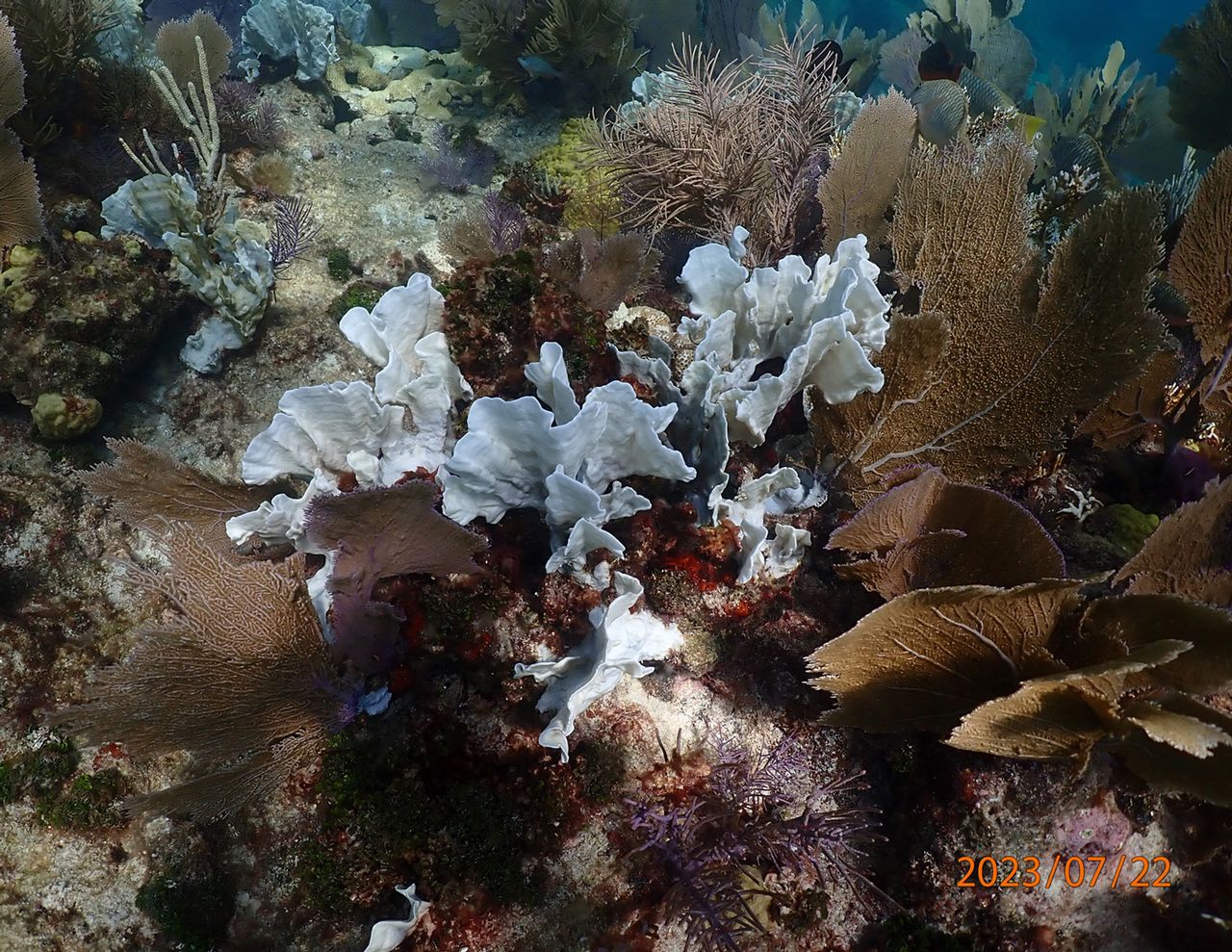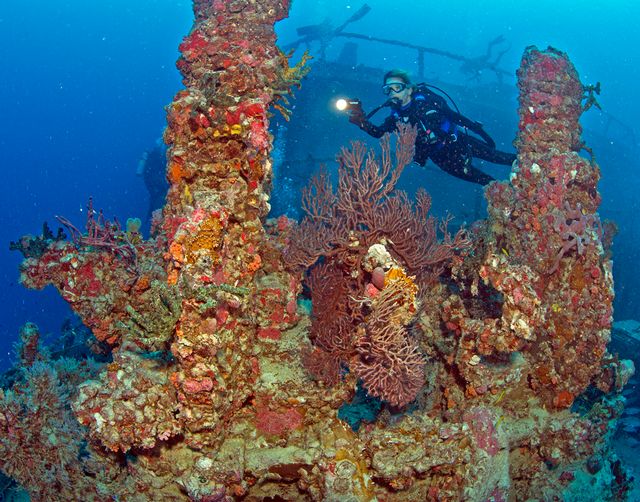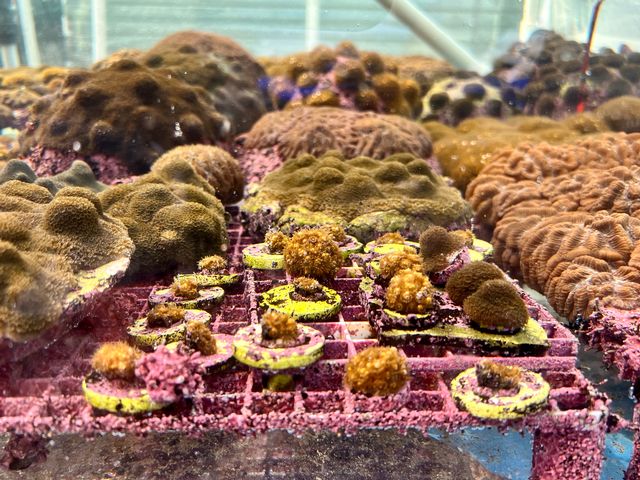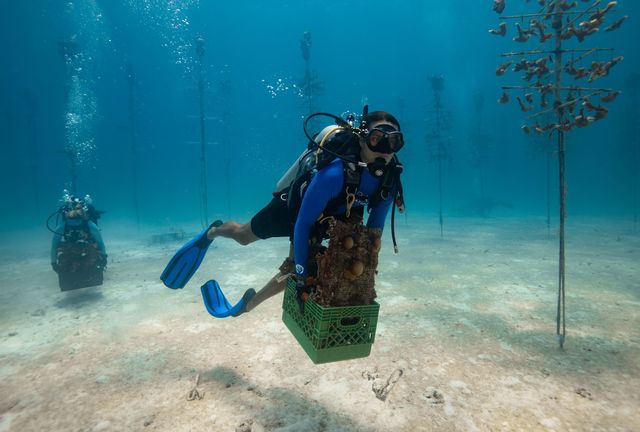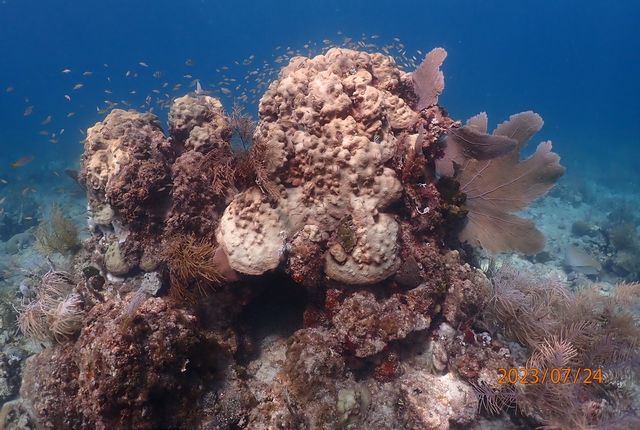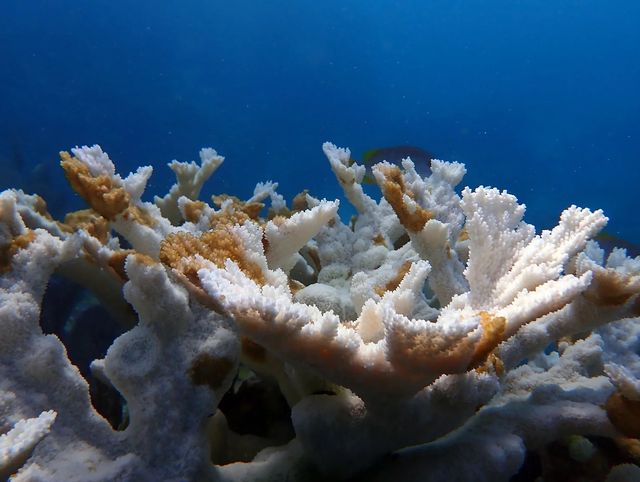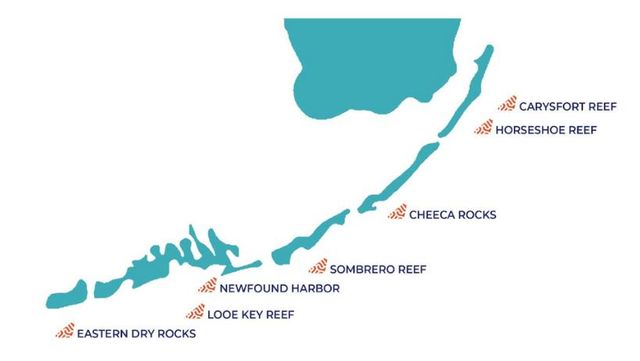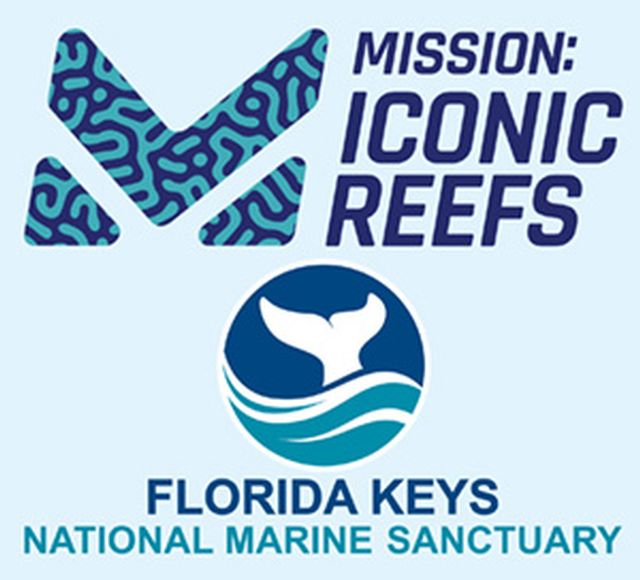Coral Bleaching on Florida Keys Reefs
With the dramatic rise in ocean temperatures seen during the summer of 2023 throughout South Florida, Florida Keys marine and coral restoration scientists raced to save coral struggling for survival along North America’s only coral barrier reef. The reef parallels the Keys island chain.
In October, Mote Marine Laboratory and the Florida Keys National Marine Sanctuary's (FKNMS) Coral Bleaching Early Warning Network indicates that currently there is low thermal stress and the coral bleaching outlook conditions are currently not favorable for a continuing mass bleaching event in the Florida Keys.
Frequently Asked Questions
About Bleaching on Keys Coral Reefs
What is coral bleaching and why does it happen?
Large-scale mass bleaching events are typically driven by unusually warm sea temperatures and calm seas. High marine temperatures stress coral, living creatures feeding on algae that provides them color and nutrients. Corals show signs of stress — expelling the algae and turning white or bleached — when water temperatures reach 87 degrees Fahrenheit.
With the heat of the summer now past, reef temperatures are averaging in the 80 degree Fahrenheit or below level. NOAA’s Coral Reef Watch has declared the threat for mass coral bleaching within the FKNMS is currently LOW.
The unprecedented marine heat wave earlier in mid-2023 created the warmest temperatures on record dating back to 1981, according to NOAA. The current marine heat wave is the longest-lasting regionally since 1991. Higher-than-average warm water temperatures were recorded starting in February, with temperatures spiking in mid and late July and early August. Florida Keys corals started paling and showing partial bleaching in early July. The passage of Hurricane Idalia as a tropical storm brought much-needed cooler water to the Florida Keys reef tract in late August and did not damage the Keys region.
Resource: Mote Marine Laboratory/Florida Keys National Marine Sanctuary Examples of Bleaching
How does bleaching affect coral?
Increasing temperatures during the spring and summer of 2023 in the Florida Keys ocean waters triggered the bleaching events.
“When corals begin to bleach, it doesn’t mean that the impacted coral is dead,” said Dr. Andy Bruckner, a research scientist with NOAA's Florida Keys National Marine Sanctuary (FKNMS), adding that it is too soon to determine to what extent different species of coral are experiencing or will experience die-off.
“Reefs in the Keys were above the bleaching threshold yet there were still sites with less temperature stress such as some in the Upper Keys,” said Bruckner. “Our deeper water reef system generally tends to be bathed in cooler water.”
Because deep water is typically cooler, the reef at sites below 30 to 40 feet is showing less bleaching. “We are looking at some of these deeper areas as a refuge for our nursery corals to take advantage of the cooler water,” Bruckner said.
Did high ocean water temps reach 101.1 degrees Fahrenheit in the Keys in summer 2023?
“That reading was recorded in Key Largo’s Manatee Bay where mud traps the heat,” Bruckner said. “This is not what we’re seeing on the reef.”
Can I go diving now in the Keys?
Yes, dive shops are operating normally, according to Keys dive industry representatives.
"There's a lot to see and divers at all of our locations say that fish are abundant with many different species reported," Captain Hook’s owner Kim Roney said, adding that dive businesses are assisting coral restoration practitioners with relocating corals in their nurseries. Captain Hook's has dive shops in Marathon, Big Pine Key and Key West.
“At the Spiegel Grove artificial reef site, coral so far has fared well,” said Chelsea McLaughlin, a Horizon Divers instructor in Key Largo.
What about diving Keys shipwrecks and artificial reefs?
There's fascinating history in cooler, deeper waters. The Florida Keys National Marine Sanctuary's Shipwreck Trail showcases nine wrecks. The Florida Keys Wreck Trek features various shipwrecks: three in Key Largo, including the Spiegel Grove; one each in Islamorada, Marathon and the Lower Keys; and three, including the Vandenberg, off Key West. The Vandenberg and Spiegel Grove are the second- and third-largest ships in the world ever to be scuttled to form an artificial reef.
Can scientists predict which areas will bleach?
Most reefs in the Florida Keys experienced some degree of bleaching. Coral bleaching varies among different species, locations, types of reef zones and a fluctuation of severity, making it difficult to predict where or when it may occur. Coral bleaching has occurred since the 1980s in the Keys. The last major event was in 2014.
Which reef areas have the most bleaching?
Sombrero Reef and Looe Key Reef experienced considerable mortality. Cheeca Rocks, Turtle Rocks and Horseshoe Reef had severe bleaching and some mortality, Bruckner said.
As of October 2023, some previously bleached coral has been observed to have regained its color, indicating it is in recovery.
Coral bleaching is not a new phenomenon and has been observed in the Keys in some form since the 1980s. The last major event regionally was nearly a decade ago. Currently most reefs in the Florida Keys are experiencing some degree of bleaching. However, as noted, the level of severity differs depending on the coral species, types of reef zones and other variables.
Are fish, lobster or other marine life affected?
High water temperatures did not appear to significantly impact stocks of Florida spiny lobster, stone crabs and native fish, said Tom Matthews, the Keys program administrator for the Florida Fish and Wildlife Conservation Commission’s Fish and Wildlife Research Institute.
"With the start of lobster season, we can confirm that there appears to be no pronounced effect on the lobster harvest this year," Matthews said. "Knowledgeable residents and experienced visitors appear to be catching their limits relatively quickly."
Matthews said that FWC officials have seen small pockets of fish die-offs in nearshore waters, but FWC has not observed fish deaths on reefs.
Pelagic species in the Gulf Stream are not expected to be impacted, Matthews said, because the Gulf Stream’s temperature remains relatively constant.
Matthews said that anyone with reports of fish kills should call 1-800-636-0511 or use FWC’s app, FWC Reporter, that can be downloaded from the App Store.
How can visitors assist?
Iconic Reef Guardians Program
Divers and snorkelers can book trips with certain FKNMS Blue Star dive operators to visit and learn about reef sites undergoing active restoration efforts as part of the Iconic Reef Guardians Program. Trained operators teach participants about reefs and restoration, and how to best experience the ecosystem.
Be a BleachWatch volunteer
Certified divers can sign up with FKNMS and Mote Marine Laboratory to be trained BleachWatch reporters. The Florida Keys BleachWatch Program creates a team of trained recreational, commercial and scientific divers who help monitor and report on bleaching and other conditions at the reefs. Divers complete data forms after each visit.
Participate in Coral Maintenance and Coral Outplanting Dives
I.CARE in Islamorada operates trips for divers to help with either maintaining reefs or ouplanting coral each Friday, the second and fourth Saturday, and first Thursday of each month. Training takes place the morning of the trip. Email: info@icareaboutcoral.org.
Use only reef safe sunscreen
Many sunscreens contain chemical ingredients that can kill corals, including oxybenzone, octinoxate and parabens, and should be avoided. Choose a mineral-based sunscreen, such as Steam2Sea, available at many Florida Keys dive and eco-tour locations.
Tour land-based coral nurseries
Visit land-based coral nursery locations for tours to learn how many species of coral are being raised in protected environments for eventual transplant to Keys coral reefs.
Plant a Million Corals
23801 Overseas Highway, Summerland Key
Monday – Friday, 9 a.m. – 4 p.m. and weekends by apppointment.
Free, but donations are appreciated. Call ahead for groups.
772-216-0391, info@plantamillioncorals.org
Mote Marine Laboratory:
Mote’s Islamorada Coral Nursery
Bud N’ Mary’s Marina, 79891 Overseas Highway, Islamorada
Tuesday, 2 p.m.
Free, but online tickets requested.
Mote’s Key Largo Coral Nursery
Reefhouse Resort, 103800 Overseas Highway, Key Largo
Monday, 3 p.m.; Wednesday, 10 a.m.; Friday, 10 a.m.
Free, but online tickets requested.
Mote’s Paradise Coral Microfragmentation Experience
Reefhouse Resort, 103800 Overseas Highway, Key Largo
Check registration calendar for dates and times
$125 per person
What’s being done to help corals?
Marine scientists and certified, trained divers are relocating healthy coral with key genotypes from the reef to the 8-acre Keys Marine Lab, located on Long Key in Layton. The facility, with more than 60 temperature-controlled tanks, serves as a coral refuge. Coral practitioners are also transferring acclimated coral to other approved land-based nursery facilities.
“We’re the halfway house for corals, which are being brought in here to take refuge from offshore nurseries. All of it will be used for coral propagation and future restoration effort,” said Cindy Lewis, director of Keys Marine Lab, currently with more than 5,000 on-site corals.
“We have to breed more resilient, stronger corals,” Lewis added. “We’re not giving up hope.”
Keys coral practitioners are working to preserve the last remaining live elkhorn and staghorn corals from Florida’s Coral Reef by gene-banking two fragments from each unique genetic individual of staghorn and elkhorn, or reef-building corals. There are about 150 unique individuals of elkhorn and 300 of staghorn, representing all species alive on Florida’s Coral Reef, to be gene-banked.
The rescued corals first acclimate at Keys Marine Lab and are transferred to other land-based nurseries accredited by the Association of Zoos & Aquariums as part of the Florida Fish & Wildlife Conservation Commission’s Florida Coral Rescue project.
Currently, outplanting of land-cultivated coral to offshore nurseries in the Keys is halted until water temperatures cool.
In Islamorada, I.CARE’s coral maintenance activities include conducting reef trips to pare back algae growing like weeds in overheated water, eradicating fire worms that feed on staghorn, and culling coral showing signs of distress or disease.
“The reality is this is a living experiment,” said Mike Goldberg, I.CARE co-founder. “The good news is we’ll have survivors: genotypes that are battle-tested. You’re going to see some that survive.”
The last major coral bleaching event in South Florida and the Caribbean began in 2014, an El Nino year, as is 2023.
“We are now rescuing as many corals as we can from our nurseries and relocating key genotypes to land-based holding systems, safeguarding our bloodstock – potentially, the last lifeline left for many of these corals,” said Phanor Montoya-Maya, restoration program manager at Coral Restoration Foundation in Key Largo.
Divers with coral restoration group Reef Renewal USA moved healthy, young coral colonies from a shallow coral nursery off Key Largo in the Florida Keys National Marine Sanctuary to deeper, cooler water, where they will remain while ocean temperatures are higher than normal. The raising of reef-building species of coral is an important part of the sanctuary’s Mission: Iconic Reefs initiative, which aims to strengthen and restore seven of the Florida Keys’ iconic reef tracts. Read more about the coral nursery relocation effort here.
What is Mission: Iconic Reefs?
Before the most recent onset of coral bleaching, NOAA's FKNMS and other conservation and scientific partners launched a bold undertaking known as Mission: Iconic Reefs that aims to restore seven key reef sites in the Florida Keys.
The innovative undertaking will restore nearly three million square feet of the Florida Reef Tract, about the size of 52 football fields, at seven iconic reef sites. It one of the largest strategies ever developed in the field of coral restoration.
Why are Keys coral reefs important?
Coral reefs prove a critical ecosystem for life underwater and protect the entire Keys by reducing the power of waves hitting the islands during tropical cyclones. They also help to support the Florida Keys economy, by providing jobs for Keys residents who offer charter excursions that take visitors to dive, snorkel and fish.
Resources
Coral Bleaching Fact Sheet: mote.org/media/uploads/Meera/BW_fact.pdf
Mote Marine Laboratory/NOAA Bleach Watch: mote.org/bleach watch
Coral Bleaching Early Warning Network: https://mote.org/media/uploads/meera/CC_20231012.pdf
Mission Iconic Reefs: marinesanctuary.org/mission-iconic-reefs/
Florida Keys Wreck Trek: fla-keys.com/diving/wreck-trek/
Florida Keys National Marine Sanctuary Shipwreck Trail: floridakeys.noaa.gov/shipwrecktrail/
Coral Reef Watch: coralreefwatch.noaa.gov/product/marine_heatwave/
A recent photo of Grecian Rocks reef in Key Largo with some coral impacted by bleaching surrounded by unaffected corals. Photo: Ken Nedimyer/Reef Renewal USA
Thousands of species of fish and marine life populate the Spiegel Grove shipwreck, its own living ecosystem covered in coral growth, as shown in this file photo. Photo: Stephen Frink
Visit land-based coral nurseries, like this one at Plant a Million Corals, to find out about the latest advances in growing coral for future planting on Keys reefs. Photo: JoNell Modys
Corals are being moved from ocean-based coral tree nurseries to land-based nurseries until ocean temperatures cool. ©CRF™
Florida Keys National Marine Sanctuary's Mission: Iconic Reefs initiative is to restore seven Keys reef sites.


